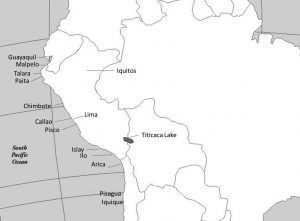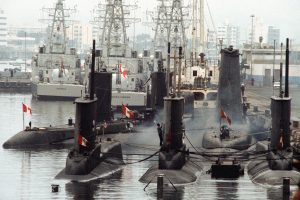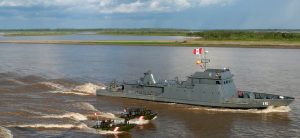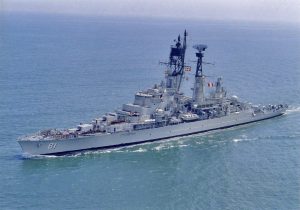- Author
- A.N. Other
- Subjects
- History - general
- Tags
-
- RAN Ships
- None noted.
- Publication
- March 2014 edition of the Naval Historical Review (all rights reserved)
By Jorge Ortiz-Sotelo
Jorge Ortiz-Sotelo is a retired Commander in the Peruvian Navy. He holds a B.A. in history from the Peruvian Catholic University and a Ph.D. in maritime history from Saint Andrews University, Scotland. For almost twenty years he taught politics and strategy at the Peruvian Naval War College and in 2008/09 he held the Shifrin Distinguished Chair in naval and military history at the US Naval Academy.
Dr Ortiz-Sotelo is the author of several books and articles on naval and maritime issues, he also was a contributor to the Guide to Documentary Sources for Andean Studies, 1530-1900 (2008), the Oxford Encyclopedia of Maritime History (2007), and the Malaspina Expedition, 1789-1794 (2001-2004). Currently he is a member of the Scientific Committee of Oceanides, Paris; general secretary of the Iberian-American Naval and Maritime History Association, and general editor of Derroteros de la Mar del Sur.
Foundations
The Peruvian Navy was established in 1821, during the War of Independence, but its roots go back deep into the Spanish colonial era, something that no other navy in the Americas can show.
As a response to Francis Drake’s intrusion into the South Seas in 1578 and 1579, the Peruvian Vice Royalty established the South Sea Armada, a permanent naval force to protect the area between the southern extreme of the continent and California. Based at Callao, the seaport of Lima and the foremost maritime centre along that coast, the Armada was entirely Peruvian, with almost all its men-of-war built at Guayaquil, in modem day Ecuador. Callao provided the manning, as well as sustaining and maintaining vessels at this homeport. At the same time, five infantry companies were created at Callao to serve on board the Armada, being the earliest marine units on the continent. In 1746 a huge earthquake and tsunami destroyed both the port and all but one of the Armada’s vessels. Two of the original five marines companies survived this calamity and the maritime defence along the Pacific was assumed by the Spanish Royal Navy. From then until 1824, several men-of-war were sent to Callao, which recovered its condition with the only naval base on the West Coast, and was raised to the more senior level of a Naval Department in 1799. Its commander-general, a flag officer, controlled a few men-of-war, the Arsenal, the Royal Nautical Academy, the Naval Hospital, and some other components of a small colonial naval force. With harbourmasters at Callao, Valparaiso, Conception and Guayaquil, he also oversaw maritime activities in the viceroyalty, including the maritime related population and merchant marine.
A Peruvian Navy
Upon these foundations the Peruvian Navy begins to be organized in the early 1820s, as part of the struggle for independence from Spain, and following the surrender of royalist forces at Callao in September 1821. Former British Commander Martin George Guise was the first Commander-in-Chief of the newly established navy, with the rank of Captain. A few foreigners were also commissioned as officers, but the bulk of the Officers Corps and ranks were Peruvians and Spaniards who previously served in the Spanish Royal Navy or the Peruvian mercantile marine. Notable amongst them were the Spanish Navy Brigadier Jose Pascual de Vivero, and the Peruvians pilots Eduardo Carrasco, Manuel Villar and Antonio Valle Riestra.
In 1821 four vessels were commissioned for naval service: the schooner Castelli, the brigs Belgrano and Balcarce; and the sloop Limena. They were followed in 1822 by schooners Macedonia and General Cruz, brigs Coronel Spano and the frigate Protector. Former Spanish Navy facilities at Callao were used for the support of the new squadron, and the Nautical Academy was reopened as the Naval Academy in November 1821. Southern Peru remained royalist controlled until its final defeat in December 1824, at the battle of Ayacucho, and another small force continue to resist at Callao, captured a few months before, until January 1826. In this context, the first missions for the Peruvian Squadron were to blockade southern ports, and to take part in two expeditions sent against the royalist. In the second expedition, sailors and marines of the frigate Presidente captured Arica. Since February 1824 until January 1826, a combined Peruvian, Chilean and Colombian squadron blockaded Callao, undertaking four attacks at the anchorage, in addition to an engagement with a Spanish squadron headed by a ship-of-the-line, and the capture of San Rafael Castle.
Vice-Admirals Jose Pascual de Vivero and Martin George Guise were the most important characters of those early years, and having an influence on the Navy for most of the 19th Century. Vivero had been Commander-in-Chief since 1823 until his death in 1834; he preserved the organization, regulations and traditions of the Spanish Navy. Guise brought British naval influence to the Navy, especially amongst those young officers who joined the squadron during the wars for Independence and later against Colombia.
Neighbourhood Wars
Due to border issues and internal political problems, Colombia and Peru went to war in 1828. The war began on 31 August 1828, when the sloop Libertad was attacked off Punta Malpelo by the Colombian naval vessels Pichincha and Guayaquileia, being repelled and forced to escape with considerable casualties. Shortly after that, the Peruvian squadron blockaded Guayaquil, and a general attack was conducted during 22 and 24 November, in which Admiral Guise was killed on his flagship, the frigate Presidente. First Lieutenant Jose Boterin took command of the squadron and continued pressing Guayaquil defenders, until it had surrender by late January 1829. The port was occupied by Peruvian forces until July of that year. Shortly before, in April, two Peruvian naval vessels raided Panama harbour, then a Colombian port, and captured two enemy privateers.

A few years later, in 1836, Peru and Bolivia became a confederation under the rule of Bolivian president Andres de Santa Cruz, despite strong opposition from some Peruvian and Chilean leaders. The latter felt that the Confederation could threaten its economy and even its independence, and therefore pushed the Chilean government to declare war on it. The war lasted until 1839, when the Confederation was finally defeated. During these years, a small Peruvian squadron cruised along the Chilean coast, landing at the Juan Fernandez Islands and in some ports, and on 12 January 1838, three Peruvian naval vessels successfully engaged a five vessel Chilean squadron off Islay. Having defeated the first Chilean expeditionary force, the Confederate government entirely neglected its navy and when a new Chilean expedition sailed north, the maritime defence was entrusted to some privateers, who fought the last naval action of this war, at Casma, in January 1839.
Modernisation of the Fleet
Five years later four naval vessels were abandoned and lost at Islay, as a consequence of a serious incident with the British Naval Station. This was a turning point in Peruvian naval history, as the government decided to invest more seriously in its naval power, ordering the construction of some ships, amongst them the Rimac, the first naval steamer in Latin America, which arrived at Callao in 1848. On the following year, the brig General Gamarra, under Commander Jose Maria Silva-Rodriguez, sailed to San Francisco to protect national interests in a region profoundly convulsed by the California Gold Rush. The General Gamarra stayed at San Francisco for almost ten months, having to land her marines to help local authorities to restore order.

A few years later, in October 1856, the steam frigate Amazonas, Captain Jose Boterin, departed Callao to undertake some repairs at Hong Kong dry-dock. Unfortunately, when she reached that British possession in China, the Second Opium War had just erupted, forcing Captain Boterin to steam to Calcutta. Repairs were done there, and afterwards the government instructed him to continue to London. After some time at the British capital, the Amazonas returned to Callao, arriving late in May 1858, having completed the first, and so far unique, circumnavigation undertaken by a Peruvian Navy vessel.
War with Ecuador: return of Spanish forces
The previous year a serious incident arose with Ecuador, as its government claimed property over a large area on the Amazon basin, which was actually Peruvian. A naval force was organized and the Guayaquil basin was blockaded for almost a year. In November 1859 Guayaquil was occupied and Ecuador was compelled to recognize Peruvian sovereignty over the disputed territories.
Just four years later incidents arose with a group of Spanish immigrants in Northern Peru which led to an international crisis, and by late 1865 a Spanish squadron commenced open hostilities with Chile and Peru. As part of it, on 7 February 1866, an allied squadron – one Chilean and three Peruvian ships – repelled the attack of two more powerful Spanish frigates at Abtao Island, south of Chile. Afterwards, the Spanish squadron bombarded Valparaiso without resistance and headed to Callao to do the same. However, they found a strong and well organized coastal defence, and a small naval squadron covering the centre of the defensive line. On 2 May 1866, the Spanish ships attacked the port but were repelled with heavy casualties. Few days later, they abandoned the Pacific coast of South America.
Inland Expeditions
While this happened in the Pacific, on the Amazon basin the Peruvian Navy was in the process of establishing a base and undertaking a considerable exploration effort, aimed at restraining the Brazilian advance westwards. Although some naval officers took part in earlier expeditions, and an unsuccessful attempt was made to run a State owned pair of small steamers in the 1850s, progress was not made until the 1860s when a substantial Government effort was provided. Some steamers were built in England, as well as proper facilities for its operation in such a remote area as the Peruvian portion of the Amazon basin, arriving at the small indigenous village of Iquitos in early 1864.
Exploration of such an extended region began immediately, and in some areas is still an on-going process, but at its earliest stages a number of incidents arose as the small steamers explored unknown rivers and had to deal with indigenous groups, some of them quite hostile to foreigners. For instance, in 1866 two young ensigns of the steamer Putumayo were murdered and cannibalized by a group of Cashibos, on the Pachitea River. This was followed by a retaliatory action by a large Peruvian expedition in which three steamers took part. After this sad mission, one of the steamers grounded and had to remain there a full year until the river’s level rose and the vessel could return to Iquitos.

War of the Pacific
As a response to Bolivian tax increases on nitrate exports, then mainly in Chilean hands, Chile occupied Antofagasta in 1879. Tied to Bolivia by a defence treaty, Peru mobilized its forces and by early April the War of the Pacific had commenced. Bolivia had no navy, and the Peruvian squadron was weaker than the Chilean one, so the only realistic course of action for Peru was to avoid a decisive engagement, and to defend its own communications lines, threatening as much as possible the lines of the enemy. Despite heavy losses, that course of action was successfully accomplished, and the main part of the Peruvian army was transported and concentrated in the southern provinces.
The small Peruvian squadron was a permanent threat to the Chilean communications lines, capturing 12 merchant ships and destroying 45 boats, both at the occupied Bolivian coast as well as at several Chilean ports. The monitor Huascar was the most notable and valuable Peruvian warship, and her commanding officer, Captain Miguel Grau, promoted to Rear Admiral during the campaign, was perhaps the most able and respected commander on both sides. The incursions into the Magellan Strait undertaken by the corvette Union, Captain Aurelio Garcia y Garcia, and the Chilean port of Tocopilla by the smaller corvette Pilcomayo are also worthy of note.
Costly as it was, the naval campaign led the Chile’s leaders to delay their decision to open a military campaign in South Peru, but this situation could not last forever. On 8 October 1879, the monitor Huascar was trapped by large and superior Chilean force off Point Angamos. The outcome of the engagement was predictable, and the loss of the Peruvian monitor opened the doors for enemy invasion.
On 3 November, a Chilean force captured the port of Pisagua, overrunning the small garrison, which included two companies of naval local reserves, and landing a large expeditionary force. Peruvian forces despatched against it were defeated at San Francisco on 19 November, and moved south to reorganize, being joined by naval reserve units from Iquique and Noria. They played an important role in the victory achieved over a Chilean division at Tarapaca, on 27 November. Despite this success, surviving Peruvian forces were separated from the Southern Army, under the command of Rear-Admiral Lizardo Montero, and therefore had to march northwards to Arica.
This port was blockaded by a number of enemy vessels, amongst them the now Chilean Huascar, Captain Manuel Thompson. On 27 February 27 1880, Thompson entered the bay and was almost immediately killed by a bomb launched from the Peruvian monitor Manco Capac, Captain Jose Sanchez Lagomarsino commanding. Shortly after, on 17 March, the corvette Union and the gunboat Alianza broke the blockade and were able to provide support to the defenders. Taken by surprise, the Chilean squadron was unable to react properly and the Union gained open sea that day. The Alianza was incorporated into the Torpedo Brigade, which by then was under the command of First Lieutenant Leoncio Prado, who would later be killed as a Colonel in the last battle of the war. Allied forces were defeated on 26 May 1880, at Tacna, and Admiral Montero ordered Colonel Francisco Bolognesi, commanding the Peruvian Arica garrison, to withdraw to Arequipa by the highland route. Bolognesi refused to abandon his position, but was unable to resist the attack of largely superior forces on 7 June. Among the defenders of Peruvian honour were the crew and garrison of the frigate Independencia, grounded at Iquique in May 1879. They manned their batteries and the command post at Fort Ciudadela, which was protected by marines from the Naval Column and the newly formed Battalion Guarnicion de Marina.
Early in April 1880 the Chilean squadron initiated a long blockade at Callao, neglecting the open sea to the remaining units of the Peruvian squadron. The monitor Atahualpa, the corvette Union, some transports and smaller units, were able to protect the port against several attacks from the blockading force. Most of the engagements were between boats, usually at night, being notable those of 23 April, when the Peruvian launch Urcos repelled the Chilean gunboats Janequeo and Guacolda; on 24 May, when the launch Independencia managed to blow up the Chilean Janequeo before sinking as a consequence of that explosion; and on 6 December, when a general action involved most of the units from both sides. It also should be mentioned that some raids were carried out by Peruvian marines at San Lorenzo Island, which had been occupied by Chilean forces, but none of them achieved the goal of destroying enemy shipping. The Torpedo Brigade was more successful, being able to detonate and sink the transport Loa and schooner Covadonga, on 3 July and 13 September 1880.
Naval personnel also took a notable part in the defence of Lima, particularly the marine battalions Guarnicion de Marina and Guardia Chalaca. Following the defeat at the Battle of Chorrillos, on 13 January 1881, both units were order to move from Callao to the defensive line at Miraflores, where a new battle was lost on 15 January. Both battalions fought bravely, being almost annihilated, but the Guarnicion de Marina not only resisted the main enemy attack but also counterattacked twice and forced them to abandon some artillery. After the fall of Lima into Chilean hands, the government moved to South Peru and some military and partisan resistance was organized in the highlands. A number of naval personnel joined these forces, amongst them Captain Luis German Astete, and First Lieutenant Leoncio Prado, both of whom would later die in battle as colonels at the final engagement of the War of the Pacific, fought at Huamachuco, on 10 July 1883. Peru was profoundly affected by its defeat in the War of the Pacific, and its political, moral and economic recovery took many years. Due to this dramatic situation, only a few units could be commissioned in the second half of the 1880s. Amongst them were the steamer Peru, when the Naval Academy reopened in 1888; and the small cruiser Lima, which were followed by transports Iquitos, Chalaco and Constitucion. Some riverine boats were also acquired for service in the Amazon Basin, amongst them the gunboat America in 1904, who had a notable participation on the wars against Colombia in 1911 and 1932. She particularly distinguished herself at the engagement held at La Pedrera, at the river Caqueta, from 10 to 12 July 1911, under the command of First Lieutenant Manuel Clavero.
The 20th Century
In 1906 two light cruisers were built in England, Altnirante Grau and Coronel Bolognesi, and although small at 3,251 tons, they had the latest advances in naval technology, including fire control system for their two 6-inch and eight 3-inch guns. In the following year, as both cruisers arrived, there also appeared the first issue of the Revista de Marina, as a regular Peruvian journal to professionally debate maritime and naval issues.
By this time, a small French Naval Mission was in Peru. Contracted in 1905, the Mission served until 1914, mostly on the Navy General Staff and at the Naval Academy. Under its influence, in 1910 two submersibles were ordered from France, Teniente Palacios and Teniente Ferre, these being the first of their kind in Latin America; and shortly afterwards the destroyer Teniente Rodriguez was purchased from the French Navy. In 1914 this destroyer was notable for being the first naval vessel to transit through the recently opened Panama Canal.
In 1919 President Augusto B. Leguia began his second administration, which after successive re-elections would keep him in power until 1930. Among his first measures were the creation of the Marine Ministry and the hiring of a United States Naval Mission, a combination which was to produce profound changes in the Peruvian Navy. Close institutional bonds were created between both navies, and a growing number of Peruvian personal was sent to the United States for training and education. Naval flying boats were incorporated to the service, from which derives the present day Peruvian Air Force and Naval Aviation, and four modern submarines were ordered from the Electric Boat Company of the USA. In 1932 a new conflict with Colombia arose for the possession of Leticia, on the river Amazon. A task force was sent to the Atlantic, and although no actual fighting took place in that area, its presence contributed to the ending of hostilities and commencement of peace negotiations. In this context, two former Russian destroyers were bought from Estonia, and were named Almirante Villar and Almirante Guise.
Early in 1941 a short but intense conflict was held with Ecuador, again regarding territorial claims. The Peruvian fleet was deployed to establish an effective control of the gulf of Guayaquil, and captured some Ecuadorian posts in that area. On the Amazon basin, gunboats were deployed, and one of them took part on the capture of Rocafuerte, on the river Napo. Following the entrance of the United States in the Second World War, Peruvian naval units were deployed in North Peru to protect the Talara oil port, as part of the continental defence efforts.
During the Cold War era, the Peruvian Navy received some former United States Navy. ships, the most notable being the arrival of the destroyers Aguirre, Castilla and Rodriguez, in 1957, not for size or armament, but because they introduced the Navy to the electronic era. Early in the next decade, two former British cruisers replaced the ageing Almirante Grau and Coronel Bolognesi, but perhaps more important was the .commissioning of the first two units with missiles, destroyers Ferre and Palacios, in 1973. A naval renovation and renewal program included the acquisition of several former Dutch units, among them the cruiser Almirante Grau, present day fleet flag-ship and the last gun cruiser in service in any navy, and the construction of German-built submarines 209 class, French-built guided missile corvettes, as well as Italian-designed Lupo class frigates. Two of the later were built in the 1980s at the Navy Industrial Service, at Callao, a facility which has built several large auxiliary ships since the 1950s. The Navy also improved its Aviation and Amphibious capabilities, incorporating several planes, helicopters, transports and landing crafts, as well as modernizing the Marines and Special Operations forces.
Further Conflict
Most of these resources, as well as those available on the Amazon Basin, were deployed in the Northern border disputes in 1981 and 1995, in two short but intense conflicts with Ecuador, before a final peace agreement was reached in 1998. In the early 1980s two leftist groups declared war on the Peruvian State, utilising terror to reach their goals. Peruvian marines were actively involved in fighting them back, and from 1990 the entire Navy took part in this effort in the large region of Ucayali, on the Amazon Basin. Marines, special operations and naval intelligence elements also fought terrorism in other parts of the country, both in rural and urban areas, being most notable the role played by the marines Special Combat Unit in the rescue of hostages held by one of these groups at the residence of the Japanese ambassador in April 1996. War against terrorism, closely tied with drug trafficking, is still on-going, mostly in a remote area of the Peruvian jungle, and naval personal are still taking part in that fighting.

Current Operations
Since the 1960s, when United Nations (UN) operations began, Peruvian naval units are taking part in several international exercises, either in the Pacific, the Atlantic or the Amazon basin. It also should be mentioned that, since 2004, marines and special operations elements have participated in the United Nations Peace Force in Haiti (MINUSTAH). Present day Peruvian naval forces are organized in two distinct Commands, one on the Pacific and the other one on the Amazon Basin, with appropriate surface, submarine, and auxiliary vessels, as well as naval aviation, marines and special operations units. The Navy is also the national authority for maritime activities, which are carried out by the vessels and personnel of the Peruvian coastguard, serving also on the Pacific, Amazon Basin and Lake Titicaca. A renovation program is currently underway, including local construction of riverine and maritime gunboats, logistic ships, as well as a four-masted training ship. In summary, the Peruvian Navy has a long and ancient history of operations in the Pacific, Amazon Basin, and the highest navigable lake in the world, with a continued goal to serve the interests of the government and people of Peru, and contribute to the peace and stability of the region.




